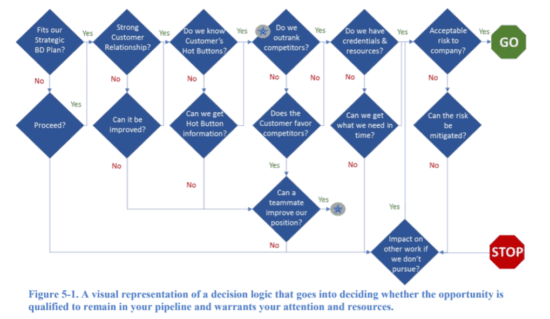Qualifying opportunities well means that your pipeline is full of opportunities with high Pwin. It is important where you spend your time and other valuable resources.
Yet, many companies suffer from poor qualifications. The spectrum of qualification ailments spans the extreme of “I don’t know how to say ‘no’ and want everything” to the extreme of “I don’t ever bid on anything because nothing seems like it’s winnable the way I learned an opportunity should be.”
How do you tell that an opportunity is the right fit, or if you should turn it down? Companies use a variety of techniques, some simple, some more sophisticated. You could start with a simple list of questions:
- What exactly is the opportunity, and is it real?
- Why does your company want this opportunity?
- How does it fit within the strategic BD plan and what is its value and return on investment?
- Does your company know and understand the customer?
- Do company’s past performance and capabilities match the requirements to be able to respond and execute, perhaps with a teaming partner?
- Where is it in the Government procurement cycle?
- How does your company stack up per the initial competitive analysis, and could it win?
- Does the company have the required facilities?
- Does the company have the resources to run a capture effort, write a proposal, and execute?
Figure 5-1 is a visual representation of the decision logic that goes into deciding whether the opportunity is qualified to remain in your pipeline and warrants your attention and resources.
Pain is the focus of your qualification: how likely are we to win this opportunity? As already mentioned, Pwin percentage is a key value in your pipeline and it is used for two purposes: to weigh the financial value of a portfolio by the probability of winning and to determine your progress of the opportunity from the capture standpoint.
You can determine your Pwin in a few ways, either each individually or combined with one another:
- Simply coming up with a number, relying on your knowledge of the opportunity, customer, and competition.
- Attach a value based on the phase – which is often used in the commercial procurements (for example, 10% is learning about a need, 30% opportunity qualified, 50% proposal sent, 90% contract sent). We are not an advocate of this approach in Government services procurements as it doesn’t have much to do with the Pwin of the opportunity itself.
- A software with an algorithm based on how well you assess you are performing in capturing the opportunity as compared to where you are expected to be for a given stage.
- Question-based calculator, with options, weighted based on an algorithm that calculates Pwin. It may combine Pgo with Pwin. The more questions you answer, the narrower is your percentage range.
Regardless of how you qualify for opportunities, you must apply rigor and not be afraid to say no. Use of a deliberate process keeps you from wasting resources on something because it subjectively “looks good” or “feels right.”
Also, note that many business developers use a superficial approach, not reading the opportunity detail, not focusing on the deal killers that are hiding in the detailed information they could easily research. Qualification warrants some thorough research and fact-finding, and some phone and legwork. Poorly qualified opportunities in the pipeline clutter your pipeline gives you a false sense of comfort that your pipeline is full, distracts your staff, and costs you money.
Your initial qualification process doesn’t stop with the first cut. You will keep validating the opportunity through the series of reviews and track the percentage of opportunities that fall off. A best practice top Government contractors have adopted is to focus on a handful of strategic actions rather than being bogged down too much in slides and process steps. Strategic actions focus on what is required to win. The task of moving the opportunity through the pipeline is to identify what needs to be done and follow through with their completion.
A pipeline must have phases that are aligned to the internal gates/reviews. For example, after you identify promising opportunities, you need to go through the opportunity identification and decide whether the opportunity is real and you want the BD team to expend “calories” to evaluate this opportunity. This is the Interest/No Interest Gate. Then, you go to the qualification phase we have discussed earlier in this section, figuring out whether you can win this opportunity, and whether it is worth winning. You get to the Pursue/Don’t Pursue gate, which initiates the process of capture and gets your company to commit resources to bid. Capture is the pre-proposal preparation, positioning yourself for the win prior to writing a proposal. You then go through a variety of capture steps, that will take you to the initial bid decision when you get to the solution development phase, and the final bid decision once the final RFP is issued. At each phase, you are still qualifying for the opportunity and can stop pursuing it at any time. The final gate is the Bid-No-Bid gate when the final RFP is released. You ensure that the evaluation criteria, for example, would allow you to discriminate against the competition.
These gate reviews and major questions allow for control and oversight from management to stop pursuits that may be a waste of time and money.
The review process is effective because it cuts out low Pwin opportunities which will not be bid, eliminating more and more as more money is invested. The real question of an organization with a healthy pipeline of qualified and captured opportunities is “can you win?”, not “can you win if we go into a heroic proposal effort and certain miracles happen?”
Contact us to learn more.

